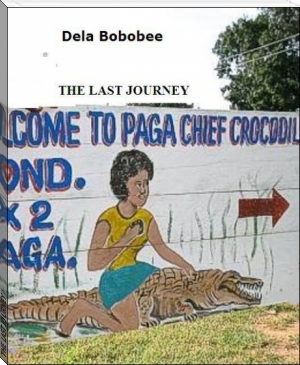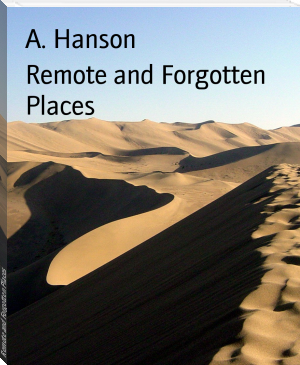THE LAST JOURNEY - Dela Bobobee (best ebook reader ubuntu txt) 📗

- Author: Dela Bobobee
Book online «THE LAST JOURNEY - Dela Bobobee (best ebook reader ubuntu txt) 📗». Author Dela Bobobee
Paga Crocodile Pond was originally a sacred sanctuary for crocodiles. All year round tourists come to Paga watch hordes of eager crocodiles responding to the summons of the attendants. Enthusiastic tourists from all over the world throng to Paga daily to watch these amazing friendly crocodiles. There are three Crocodile Ponds in Paga. These three ponds together contain about 500 Nile Crocodiles. For over the centuries these crocodiles have been considered sacred by the villagers. There are various totemic legends about these crocodiles. In Paga humans and crocodiles live here in full harmony, not bothering each other.
The best accessible Pond among the three Crocodile Ponds is the one situated along the highway to Burkina Faso border. We decided to go there to see for ourselves these amazing crocodiles. It is just one kilometre from the border checkpoint. There is a signboard with the caption of a human riding on the back of a crocodile. The signboard boldly designates it as “Welcome to Chief Crocodile Pond”. The guides were awaiting customers in a signpost summer hut situated between the Pond and the road.
The surroundings of the Chief Crocodile Pond was quite neat. Contrary to the many previous complaints about place we were surprised to see a whole new facelift. Stories in the past had it that at the Pond there were some unkempt individuals who demanded exorbitant money each before one could even visit the Pond. There were complaints then that they demanded high price to buy the fowl, which will entice the crocodiles from the Pond. Then the place around the Pond was said to be soggy and tourists had to get their footwear wet trying to get to the Pond. Many complained that there was no form of entertainment and they had to walk about a kilometre to the border to get to a joint to quench their thirst.
It may be true that in the past, tourists had to negotiate the fees with uncompromising individuals. Fortunately for us all that has changed now. We were surprised that in recent times the village of Paga has been developed under the auspices of Community Based Ecotourism Program. This was done with the assistance of Peace Corps volunteers and so now we were presented a menu with a choice of excursion options and additional services all at fixed rates.
Towards late afternoon we were joined by more tourists. There were a handful of European and American tourists present but the local Ghanaian tourists outnumbered the rest. Students from other parts of Ghana came there on excursion. Many Ghanaian couples came in their private cars with their families. We paid the necessary guide fees part of which is set aside for community development projects in Paga. We paid extra money to the guides to buy the fowls; some of the local tourists brought their own fowls from home too. We were ready to witness what is termed the Crocodile Pond Ritual. The procedure takes the form of a defined ritual performance involving the tourists, guides, fowl and the crocodiles.
First, the tourists would provide a live chicken to the guides who would call out to the crocodiles using the fowls as bait to entice them to come out of the pond. The guide whistles a tune and this excites them and makes them come out of the water, and then he waves the live fowl in the air for the crocodile to come to the dry land. The tourists can then pose for photographs with crocodiles, and after that they are rewarded with a fowl which is gulped down with gusto.
Indeed the guides are necessary to lure a crocodile from the Pond; otherwise we would not be able to see any. That was why we were charged extra money for the fowls. We walked to the Pond for 30 to100 metres and we watched the guides in awe as they started to whistle and vigorously shake the poor fowl in his hand. The terrified fouls made a lot of noise which I guess was meant to attract the crocodiles and acquaint them with the prospect of a free meal. At first nothing happened. I guess it all depends on the season and the time of the day to determine whether the crocodiles are ready to show up. All we had to do was to patiently wait for them to show up. The waiting lasted for about fifteen minutes.
It took fifteen minutes of hard work by two guides who energetically flapped the fowls in the air before the crocodiles eventually appeared. We were lucky as three medium sized Nile Crocodiles eagerly came out of the pond. They were rather young crocodiles in their prime. They looked quite big and lazy. Some of the tourists felt disappointed that they were not the really big ones and that they could not be able sit on them to pose for their photographs but we were all happy that they came after all. Now the waiting was over. There was a visible release of unsuppressed excitement among the tourist when the three Nile crocodiles approached us. I do not really know how to describe the intensity of my exhilaration. Indeed I am a pet lover and have seen hundreds of crocodiles in zoos and national parks in Africa before, but this whole thing took a novel dimension. This was the first time I came near or saw a crocodile at such a very close range. This was where I had my closet encounter with crocodiles. My excitement was overflowed with blissful emotions. I quickly got my camcorder ready and positioned myself at a vantage point to get the best focus of the whole action. Intuitively, I wondered how the guides were going to share two fowls among the three eager looking crocodiles approaching us at a leisurely pace.
Apparently my vantage position at the forefront might have been misleading and precipitated the idea to one of the crocodiles that I might be one of the guides and my camcorder was a fowl that was meant for it. It came to me with its formidable huge snout wide open and was waiting for it. Although I claim to be a professional wildlife videographer, I always do that at a discreet distance with the aid of very sensitive telescopic lens. I also know that I am no crocodile catcher, charmer or expert. I did not intend to be no Steve Erwin either, and so all my excitement suddenly turned into a momentary premonition, and the need for safety became foremost in my mind. Intrinsically I knew that this portends danger. In Africa we are thought to have respect for the wild. Instinctively I cringed and jumped backwards quickly out of range of the approaching crocodile, in case it lunges for a grab of my hand out of frustration. Although they claimed there was no known record of crocodile attack to humans in the history of Paga, I was not going to lose my guard. Of course, I knew that no matter how legendary their alleged friendliness, these Nile crocodiles were no vegetarians when we were told to offer them meat, live chickens for that matter.
When the crocodiles were completely out of the water, they relaxed docilely near the bank. The guides motioned us that we could now pose for photographs with the crocodiles. It was time for the tourists to perform their own part in the ritual by taking photographs with the crocodiles. Some of the tourists came with their own cameras. They were all dressed to look their best in the photograph of their lives. The students were busy taking group photograph with their own digital cameras which needed no film to function. Some had manual cameras but no film.
The guides were making good brisk business by taking the students pictures, using their own cameras as most of them had no cameras. You have to pay the guide-turned photographers in advance and can pick the photographs or have the photos the next day if you are staying overnight. Although they advertised with the caption of “Have your photo taken sitting on the back of a crocodile”, there were two conditions involved. First the crocodile must be really huge; secondly the human must be tiny, which in reality is only feasible for little children in rare cases. The only option left for us was to just pose by squatting near the crocodiles. Some bold ones touched, shake hands, and grabbed the tails of the crocodiles. I took as many shots of photographs and video footages as much as I could.
The crocodiles were really tamed, well behaved and patient. They waited patiently for the tourists to take as many pictures as they wished. This is the fun part of the ritual; one can touch, caress or even sit on these reptiles. Paga is the only place on the planet earth where you can pose for your memorable photos, sitting and holding the tail of some of the biggest crocodiles in the world. About twenty tourists could take pictures with only just one crocodile. After the tourists were done with the photographs, the crocodiles finally got their rewards for their mutual cooperation and patience. Incidentally the guides completed the tally of three chickens and offered the equally to the crocodiles. The munching and gulping of the chicken by the crocodiles was really spectacular. It was done in a noisy concerto, a flurry of flapping wings and crunching bones. After dinner the three satiated crocodiles did not see any further reason to amuse the tourists. They lazily slide back into the water and swam away contentedly.
The whole Crocodile Pond ritual ceremony took about thirty minutes, and I guess both parties found it a big fun, except me. I wanted something more than that. I told the guides that I wanted to take a video of a human riding on the back of the crocodiles in the pond. They told me that would cost me additional money. I came all the way to Paga prepared for that, and so I readily agreed to their rather exorbitant price. Eventually two very young boys were fetched from the village to ride on the back of the crocodile in the water. I asked if they are sure the kids could swim and no harm would befall them in the water. It is a different thing to touch or pose with a crocodile outside the water and another thing entirely to venture into their lair. The guides allayed all my fears by assuring me that the kids are locals and adept swimmers who have passed through the same ritual several times before. Good, I just wanted to be sure no one would be held responsible for whatever accidents that may take place.
No accidents took place. The kids waited excitedly for another crocodile to be lured out of the water for a chance to ride on their back. The Crocodile ritual performance took place again, only that this time the waiting was shorter. I did not know exactly how they did it but this time around we did not have to wait for a longer period before two very giant Nile crocodiles came out of the water. I guess I was twice lucky in one day. The two crocodiles that came out of the water were really some of the largest in the Chief Crocodile Pond of Paga. After the crocodiles were fed the kids climbed onto their backs. Enthusiastic tourists cooed with glee when the two monstrous crocodile slide back into the water with kids snugly clinging legs bestriding their ample rough backside. The crocodiles swam the whole length of the pond with the kids





Comments (0)